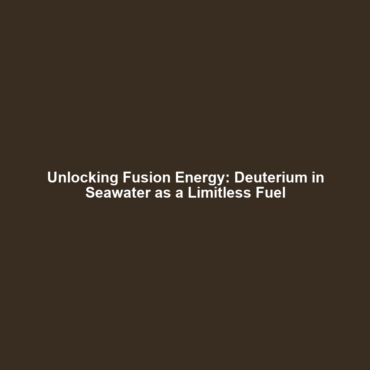Abundance of Deuterium: A Limitless Fuel Source for Fusion Energy
Introduction
Deuterium, an isotope of hydrogen, is abundantly present in seawater, making it a promising candidate for fusion energy. As the world races to find sustainable and limitless energy sources, deuterium’s availability could revolutionize the way we think about energy production. Fusion energy, which mimics the processes powering stars, offers a clean, virtually inexhaustible source of power, provided that deuterium can be harnessed effectively. Understanding the significance of deuterium’s abundance in seawater is vital as we explore the future of fusion energy.
Key Concepts
The Role of Deuterium in Fusion
Deuterium is significant in the fusion process, particularly when combined with tritium, another hydrogen isotope. The fusion of deuterium and tritium releases a tremendous amount of energy, which can be harnessed to generate electricity. Key concepts in fusion energy include:
- Fusion Reaction: A reaction where light atomic nuclei combine to form a heavier nucleus, releasing energy.
- Plasma State: The state of matter necessary for fusion, where electrons are separated from their nuclei.
- Containment Methods: Technologies such as magnetic confinement and inertial confinement designed to sustain fusion reactions.
Applications and Real-World Uses
Deuterium’s abundance significantly contributes to various applications in fusion energy, including:
- Nuclear Fusion Reactors: Deuterium serves as a primary fuel source in experimental reactors like ITER, aiming to demonstrate the feasibility of fusion energy.
- Hydrogen Production: Deuterium is utilized for producing hydrogen fuel through fusion, which can lead to cleaner energy solutions.
- Scientific Research: Deuterium is extensively used in laboratory settings to study fusion processes and advance our understanding of plasma physics.
Current Challenges
Despite its potential, there are several challenges associated with the study and application of deuterium in fusion energy:
- Technological Limitations: Current fusion reactors struggle to achieve the necessary conditions for a net-positive energy output.
- High Costs: The development and maintenance of fusion reactors require significant financial investments, posing economic hurdles.
- Public Perception: Misunderstandings about nuclear fusion and safety concerns can hinder investment and research initiatives.
Future Research and Innovations
The future of fusion energy is promising, with ongoing research aimed at overcoming current challenges. Innovations may include:
- Advanced Materials: Development of new materials that can withstand high temperatures and radiation in fusion reactors.
- Improved Containment Technologies: Enhancements in magnetic and inertial confinement methods to achieve sustained fusion reactions.
- Integration with Renewable Energy: Combining fusion energy systems with existing renewable technologies for a holistic energy solution.
Conclusion
In summary, deuterium’s abundance in seawater positions it as a virtually limitless fuel source for fusion energy. As ongoing research continues to address current challenges and drive innovations, fusion energy has the potential to reshape our energy landscape. Moving forward, investment in fusion technology and public support will be essential. For further reading on related topics, consider exploring our articles on renewable energy sources and nuclear energy developments.

Leave a Reply